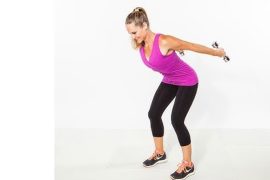Enhancing running performance involves more than just logging miles; incorporating targeted strength exercises is crucial for runners seeking to improve speed, endurance, and injury resilience. Effective strength training for runners goes beyond traditional leg exercises, encompassing a holistic approach that addresses core stability, balance, and flexibility. Engaging in a routine that includes exercises such as squats, lunges, planks, and resistance training not only fortifies the major muscle groups but also aids in preventing common injuries. Integrating these strength exercises into a comprehensive training plan can optimize overall running efficiency, promote proper biomechanics, and contribute to a well-rounded athletic performance.
Running is a full-body exercise that engages various muscle groups, contributing to overall strength and endurance. The core muscles, including those in the abdomen and lower back, play a crucial role in stabilizing the torso and maintaining good posture during running. The hip flexors are involved in lifting the legs, while the glutes provide power and propulsion. The quads work to extend the knee, and the calves are essential for pushing off the ground and facilitating the ankle movement. To complement these natural movements and prevent imbalances or injuries, incorporating targeted strength exercises for these muscle groups is essential for runners. This comprehensive approach ensures a well-rounded fitness foundation, supporting improved performance and reducing the risk of overuse injuries.
Incorporating strength training into a runner’s regimen can enhance performance, reduce the risk of injuries, and improve overall fitness. Here are some effective strength exercises for runners:
1. Forward-to-reverse lunge:
The forward-to-reverse lunge is a dynamic lower body exercise that targets the quadriceps, hamstrings, glutes, and calves while also engaging the core for stability. Begin with feet hip-width apart and hands on hips or clasped in front of your chest. Brace your core and step the left foot forward, bending both knees to create a 90-degree angle with the front shin and thigh. Push through the left foot to return to the starting position. Subsequently, step the left foot backward, again forming a 90-degree angle with the back shin and thigh. Alternate between forward and reverse lunges, ensuring proper form and maintaining core engagement throughout. This exercise not only strengthens the lower body but also improves balance and coordination. It can be tailored to individual fitness levels by adjusting step length and depth.
2. Glute bridge:
The GGGGG is a foundational bodyweight exercise that targets the upper body, particularly the chest, shoulders, and triceps, while also engaging the core for stability. To perform a push-up, start in a plank position with hands stacked under shoulders and body forming a straight line from head to heels. Lower your chest toward the floor by bending your elbows at a 45-degree angle, ensuring a controlled descent. Engage your core to maintain a straight body position, avoiding sagging hips or elevated glutes. If needed, modify by performing the exercise with knees on the ground or elevating hands on a stable surface. Push through your palms to straighten your arms and return to the starting position. The push-up is an effective and versatile exercise that can be adapted to different fitness levels, contributing to overall upper body strength and core stability.
3. Glute bridge
The glute bridge is a targeted exercise that engages the muscles of the lower body and core. To perform a glute bridge, lie on your back with arms at your sides. Bend your knees and position your feet flat on the floor, hip-width apart, with heels about six to eight inches away from your glutes. Engage your core muscles and contract your glutes as you lift your hips towards the ceiling, forming a straight line from your knees to hips to shoulders. Avoid arching your back and only lift as high as your body allows. Hold the top position for a couple of seconds, emphasizing glute contraction, before slowly lowering your hips back to the floor. This exercise effectively targets the glutes, hamstrings, and core, promoting strength and stability in the lower body. Ensure controlled movements and proper form throughout the exercise to maximize its benefits.
4. Lying leg raises
Lying leg raises are a targeted exercise that primarily engages the abdominal muscles and lower body. To perform this exercise, lie on your back with your arms at your sides and legs extended. Press your lower back into the floor and bring your legs and feet together. With your lower back firmly against the floor, squeeze your legs together and lift them a few inches off the floor, maintaining pointed toes. Engage your abdominal muscles as you slowly lower your legs towards the floor without allowing your lower back to lift. Lift your legs again without letting your feet touch the floor between repetitions. This exercise effectively targets the lower abdominal muscles and helps improve core strength and stability. To maximize benefits, focus on controlled movements and maintain proper form throughout the exercise. Adjust the difficulty by varying the height to which you lift your legs.
5. Superman back extension:
The Superman back extension is an effective Strength Exercises for targeting the muscles of the lower back and glutes. To perform this exercise, lie flat on your stomach with your legs extended behind you and arms reaching overhead, resting your forehead and arms on the floor. Inhale deeply, then exhale as you simultaneously lift your arms, chest, and legs off the ground. Keep your hips pressed to the floor and maintain a straight line from your neck to your spine. Squeeze your glutes and hold the lifted position for a breath or two, emphasizing the contraction in the lower back and glute muscles. Slowly and with control, lower your arms, chest, and legs back to the floor. The Superman back extension helps strengthen the muscles along the spine and improve overall back stability. Focus on controlled movements and proper form to maximize the benefits of this exercise.
6. Double-leg jumps with a jump rope:
Double-leg jumps with a jump rope are an excellent cardiovascular Strength Exercises that also enhances coordination and agility. Begin by holding one handle of a jump rope in each hand, and stand with your feet hip-width apart, ensuring the jump rope is on the floor behind your feet. Maintain an upright posture, tucking your elbows close to your torso with arms bent at about a 45-degree angle and hands angled slightly away from your hips. Rotate your wrists to swing the jump rope overhead and in front of your body. Just before the jump rope makes contact with the floor, execute a jump with both feet, allowing the jump rope to pass beneath. Land softly on the balls of your feet with a slight bend in the knees, and immediately prepare for the next jump. This exercise not only improves cardiovascular fitness but also works on lower body strength and endurance. Focus on a consistent rhythm and proper form to maximize the benefits of this dynamic and fun workout.
7. Box jumps:
8. Calf raises:
Calf raises are a straightforward, yet effective Strength Exercises aimed at strengthening the calf muscles. Whether performed on the floor or a stable step or bench, the key is to stand with feet hip-width apart, toes pointing forward, and heels either on the ground or hanging off an elevated surface. Balancing against a wall, raise both heels, lifting onto the toes and squeezing the calves at the top of the movement, holding for one to two seconds. Slowly lower the heels back down, and if on a step or bench, achieve a deeper stretch by lowering below the surface. For added challenge, variations include performing the exercise one leg at a time or incorporating a dumbbell for resistance. Calf raises contribute to improved lower leg strength and stability, emphasizing controlled motions and proper form for optimal results.
It’s essential for runners to maintain proper form during these Strength Exercises and to gradually increase intensity to prevent injuries. A well-rounded strength training routine, combined with a proper warm-up and cooldown, can significantly contribute to a runner’s overall performance and well-being.
Disclaimer:
The information contained in this article is for educational and informational purposes only and is not intended as a health advice. We would ask you to consult a qualified professional or medical expert to gain additional knowledge before you choose to consume any product or perform any exercise.








